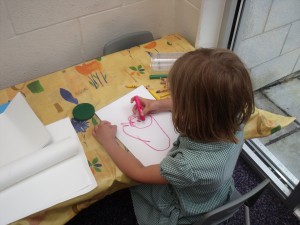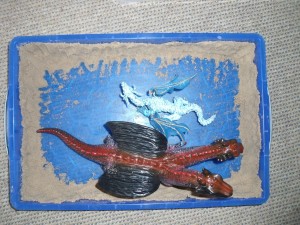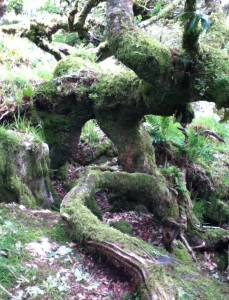The state of reverie, or hypnogogic reverie, has been researched through the 1970’s, as a natural altered state of consciousness, linked to meditational trance and hypnotic drug use. Creative/Expressive Arts are known to produce this change of consciousness, as well as healing and therapeutic work. CLIA is committed to raising awareness of this natural ability we all have of feeling ‘lost in time’, creatively absorbed or just blissful, and the understanding that through this our emotional experiences are re-integrated and ‘settled’. The events involving Expressive/Integrative Arts and Visioning (R) that we plan aim to support our efforts in feeling re-connected with an often confusing and stressful world, through a relaxed, peaceful state. Creative Journal is like a meditation, an extended daydream and a sort of self-counselling experience of playful reflection.
This is often experienced when out in natural landscapes or being fully absorbed in what we are doing.
The Play Team Association developed training in Non-Directive Play and ran events in Expressive Arts for families, describing the creative and healing effects of our natural ability for empathic listening and formless reverie during play.
Written by the founder and Creative Director of Play Team, for the Play Therapy UK Congress of 2010, held in Morocco, the following article introduces the healing effects of ‘formless’ (or creative/healing) reverie as it is experienced in non directive play with children.
‘Formless Reverie’
Abstract for PTUK Congress 2010.
A paper by Prof. Anna Clarke. Creative Director of The Play Team Association. (www.ukplayteam.org)
Since I trained with Rachel Pinney work under her supervision 23 years ago I have been interested in the part reverie plays when it occurs in a session with a child. This meditational state can be mutually entered into by both child and practitioner and appears to have a profoundly healing effect. It is spontaneous and cannot be contrived but when it happens creativity appears to blossom. The child sometimes hums quietly and the concentration is deeply held. I am working with a child at the moment and have been for nearly two years, so have been in a position to observe this process and become aware of its value. Winnicott describes the early infant mother relationship where the infant is an extension of the mother’s breast. There is a mutual synchronicity. Attachment theory shows the importance of this early relationship with a good enough mother. During a “Special Play Time” I provide a selection of art materials. Some children prefer toys and cars, dolls etc. but many of them gravitate towards the paint or the clay or the sticking.
Sandplay is very popular and can be an ideal vehicle for the process of reverie. As Marion Milner writes the reverie “leads to that very otherness from oneself which makes any subsequent sadness at loss possible” It is this “sadness at loss” which can be accessed by the child and a process of healing can take place whilst using the art materials or the sand. This state is reminiscent of the forementioned mutuality between the mother and baby, the non verbal communication where the mother reflects back to the child through the “mutual gaze” during feeding at the breast. From this proceeds the development of the early awareness of “me and not me” The child can then be secure enough for a short time to flounder and still trust. Winnicott allowed adults to experience this formless reverie from which a new sense of integration can emerge.
The reverie allows the client to be in touch with this safe maternal experience in a secure environment where “rudimentary play” can take place. In this neutral zone it is safe to go into the unintegrated state of the personality where healing can take place through creativity, as long as there is a process of reflecting back. This seems to be the key to the work we do with children who may not have had the experience of the mutual gaze. When we reflect back what they are doing we are giving them a healing opportunity. I would like to explore this in my talk, mentioning Winnicott, Bion and Maslow’s thinking on the subject and also the work of Marion Milner. If children can receive this reflection at an early age, even if they have not been lucky enough to experience Winnicott’s “dance of intimacy” there is hope that a remedy can be found.
Anna Clarke at Play and Creative Reverie in Denmark
References:
- Milner, M (1950) ‘On Not Being Able to Paint’ International Universities Press, Inc. Madison, Conn.
- Pinney Dr R. (1990) ‘Children’s Hours’, Children’s Hours Trust, London
- Pinney Dr R. (1983) Creative Listening, A to Z Printers & Pubs., London
- Rogers, C (1961). ‘On becoming a person: A therapist’s view of psychotherapy’. London: Constable.NY.
- Winnicot, D W (1999) ‘The Family and Individual Development’, Routledge, London
- Anna Clarke, 2010 (edited 2012)
For more information:
Introduction to the Play Team Association
READ MORE about the Science of Sound and Natural Spirituality.
CREATIVE REVERIE
A creative reverie can envelop a group as it walks with awareness through a landscape, generating poetry, song improvisation, and mandala. Nature herself seems to trigger the senses through strong magnetic pulses, soft sounds, bright colours and flowing organic forms. Going out into ancient hillsides containing imaginal (symbolic) sites used to conjure healing and vision in the old days, evokes a sense of lyrical connection, an unspoken awe, a relaxing reverie, that can empower any dream or vision, soothe away a problem and bond a group at a philosophical level. Our heart’s desire, like a tender bud, is strengthened and reinforced by the magnetism of landscape, tree and river as we pass through.
Improvising with poetry and song at Wistman’s Wood 2012.
In the Gatekeeper Trust programme (www.gatekeeper.org) I offer ‘Healing Altar’s in the Landscape’ in which expressive arts help us explore the ‘Spirit of Place’ or the natural bio-electric magnetism with which trees and growing things surround us. Using heart vision, attunement, sound, and improvised mandala and dance, we re-enact what must have been the way early societies rooted their cultural memories, and achieved psychological bonding through natural reverie.
Mandala in Wistman’s Wood, 2011. The rare dwarf oak trees inspired our improvised poetry and song, as well as a circular ‘mandala’ art form of leaves and sticks in the centre of the group.
Wistman’s Wood 2012.
BIO-ELECTRICITY
Satya Singh and Fred Hageneder ** speak of the research at Yale University that proved the bio-electrical field of trees, and this they say is reinforced by ages old practice of ‘tree shrines’ in nature in which people could access healing and expanded consciousness . ‘The charge within the electrical field of trees follows a rhythmical pattern. The voltage is at its lowest in the early morning and at its highest at noon. During the year in the northern hemisphere a tree’s lowest voltage is found in April and its highest in September. The bioelectrical fields of trees react to very subtle changes in light, atmospheric charge and the earth’s magnetic field.’
Kingley Vale, Sussex, 2011. These huge yew trees are over 1,000 years old, and the stillness within the wood almost tangible, as is a sense of protection, wisdom and rootedness in time. This contributes to the ‘Spirit of Place’ and its empowering effect on memory.
**’Because the bio-electrically active layers can be found just under the bark, hugging trees has a deeply vitalising effect on us. The same is true for sitting with your back resting on a tree… the flow of energy going through the tree can directly interact with the spine and energetic processes of the human brain. *
**’Tree Yoga’ by Satya singh and Fred Hageneder, 2007.
Kingley Vale, 2011.
Like an armchair, the old yews cradle you with a thousand years of watchful stillness.
I made this collage before I started a series of events entitled ‘Healing Altars in the Landscape’:
I am a dreaming spirit in the woodland cathedrals of this land.










